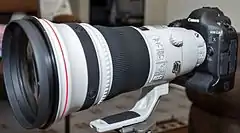Dragonfly Telephoto Array
The Dragonfly Telephoto Array is a ground-based optical telescope array developed at the Dunlap Institute for Astronomy & Astrophysics of the University of Toronto in Canada. The array uses a combination of telephoto lenses to observe extragalactic objects.[1] Its main purpose is to take images of ultra-low surface brightness galaxies at visible wavelengths of light. It is well suited for this purpose because its lenses have specially-coated optical glass that reduces scattered light.
Design

The telescope was designed by Roberto Abraham of the University of Toronto and Pieter van Dokkum of Yale University.[2] It was commissioned in 2013[1] and initially had eight commercially available Canon EF 400mm f/2.8L IS II USM camera lenses.[3] This was first increased to ten lenses, and was extended to two clusters of 24 lenses each in 2016.[4][5][6] The array is designed to accommodate the addition of lenses to increase its effective aperture with each additional lens.[3]
With 48 lenses, the instrument has a light gathering power equivalent to a 400 mm f/0.4 lens, or a refracting telescope with an objective lens diameter of 990 mm (39 in). In March 2021 plans were announced to add 120 more lenses.[7]
By using a lens based refactor design rather than a mirror based reflector design the telescope suffers less from issues introduced by diffraction and light scattering.[8] Reflector designs have more light scattering due to interactions with dust and any slight roughness on the mirror.[8] Issues with diffraction occur due to the need to place obstructions in the optical path of reflecting telescopes.[8]
Research
Astronomers used the Dragonfly Telephoto Array to discover Dragonfly 44, a galaxy that is roughly as massive as the Milky Way, with 99.9% of its mass composed of dark matter.[9] At the other end of the scale it was also used to discover NGC 1052-DF2, which measurements with other instruments initially suggested was a galaxy with very little dark matter.[10] Further work indicated that NGC 1052-DF2 was closer to the earth than previous thought.[11] If this is the case then the galaxy appears to contain a typical amount of dark matter.[11]
References
- "Dragonfly - Dunlap Institute". Dunlap Institute for Astronomy and Astrophysics. Retrieved 5 March 2018.
- "A New Kind of Telescope". University of Toronto Magazine. Retrieved 29 May 2020.
- Abraham, Roberto G.; van Dokkum, Pieter (January 2014). "Ultra – Low Surface Brightness Imaging with the Dragonfly Telephoto Array". Publications of the Astronomical Society of the Pacific. 126 (935): 55. arXiv:1401.5473. Bibcode:2014PASP..126...55A. doi:10.1086/674875. S2CID 119197160.
- "How Do You Make A Galaxy Without Dark Matter?". Dunlap Institute for Astronomy and Astrophysics. Retrieved 15 Apr 2019.
- Estes, Adam C. "Astronomers Invent New Telescope by Tying Telephoto Lenses Together". Gizmodo. Retrieved 5 March 2018.
- "Dragonfly - Yale University". Retrieved 5 March 2018.
- Lens array captures dim objects missed by giant telescopes, Science, Vol 371 p1301 26 March 2021
- Jielai Zhang (2018). The Development and Scientific Application of the Dragonfly Telephoto Array (PDF) (PhD). University of Toronto. p. 10.
- "Meet Dragonfly 44, the galaxy made of 99.9% dark matter". Wired. Retrieved 5 March 2018.
- Van Dokkum, Pieter; Danieli, Shany; Cohen, Yotam; Merritt, Allison; Romanowsky, Aaron J; Abraham, Roberto; Brodie, Jean; Conroy, Charlie; Lokhorst, Deborah; Mowla, Lamiya; o'Sullivan, Ewan; Zhang, Jielai (2018). "A galaxy lacking dark matter". Nature. 555 (7698): 629–632. arXiv:1803.10237. Bibcode:2018Natur.555..629V. doi:10.1038/nature25767. PMID 29595770. S2CID 4460376.
- Trujillo, Ignacio (14 March 2019). "A distance of 13 Mpc resolves the claimed anomalies of the galaxy lacking dark matter". Monthly Notices of the Royal Astronomical Society. 486 (1): 1192–1219. arXiv:1806.10141. Bibcode:2019MNRAS.486.1192T. doi:10.1093/mnras/stz771. S2CID 118889598. Retrieved 5 June 2019.